Searching for "library"
The New Horizon Report, 2016
http://www.nmc.org/nmc-horizon-news/nmc-launches-app-for-the-2016-nmc-horizon-report/
page 24. Improving Digital Literacy
For years educators have leveraged curation tools such as Scoop.it, Storify, and Pinterest to help students critically evaluate online resources.
(my bold to emphasize the difference between the definition of digital literacy, which I am fighting to establish at SCSU LRS and the continuous “information literacy” trend of the reference librarians )
Mapping Digital Literacy Policy and Practice in the Canadian Landscape
A well-rounded digital literacy incorporates print literacy but adds new capacities, competencies and comportments into the mix. Now included is the technical know-how to create a website, produce and upload a video, edit an image, design a functional information architecture for accessing or sharing knowledge – as well as many “soft skills” such as critical thinking and ethical behaviour. One of the primary transformations of the digital era in the 21st Century has been the introduction of end-users as actors in the world of communication, autonomous (producers and consumers of information) who can access and disseminate content in Web 2.0 domains without the regulatory controls of traditional filters and gatekeepers. Given this development, end-users now need greater critical thinking capacities to manage content: to decide what is valid and truthful and be able to incorporate multiple perspectives and voices into expanding worldviews. Additionally, exhibiting ethical behaviour in what may be said or posted online is essential to contemporary civic mindedness whether in a local context or the broader global village.
Getting Started: Multimedia Literacy
http://guides.lib.udel.edu/multimedia
Multimedia literacy is the set of abilities that enables an individual to effectively find, interpret, evaluate, use, and create multimedia.
http://www.deakin.edu.au/library/teach/digital-literacy/elements-of-digital-literacy – too simplistic, too traditional, no significant departure from the conservative information literacy
More on digital literacy in this IMS blog:
https://blog.stcloudstate.edu/ims?s=digital+literacy
Our discussion:
++++++++++++++++++++++++
Main speaker: Ken Chapman
mapping what students are looking at the screen
intelligent agent: dancing hamster
immediate gratification – certification, this is practically badges
story builder – D2L tool
D2L dropbox – look previous assignments and submissions within dropbox
time savers: 1. miss an assignment deadline – use agent. My note: how does it roll over? how much time and effort to condition it after it is rolled over?
text expanders: create codes in the browsers to evoke repetitions (;runon)
“Daylight Experience” is the D2L new look and feel put on D2L. nice clean modern looking.
Mobile First, API Access, Assessments, Advanced CBE (competency-based education programs), Predictive Analytics (recommendation system to pick right course, red flags, Dashboards,
Content:
interactive publisher material. Dates and Feeds on Mobile, Curriculum Planning
Capture: my note – how does it fit with MediaSpace
ePortfolio my note – how does it fit TK-20
Repository – open content, publishers, how to bring easier into a course
Adaptive learning
D2L purchased a module. publisher packets, adaptive textbooks. D2L looks at it as an engine where faculty feeds the idea and the engine is making the links and structuring the ideas into content. It also the engine checks what learners already know and based on results finds knowledge gaps.
need well defined learning objective, good content and ways to assess the material.
Start with creating support course delivery, test preparation.
There are only 11 education-focused firms listed on the U.S. stock market with a market cap of over $1 billion. While the market is small and fractured today, GSV Capital estimates that education will grow from 9 percent to 12 percent of America’s GDP over the next decade. This equates to a trillion-dollar opportunity.
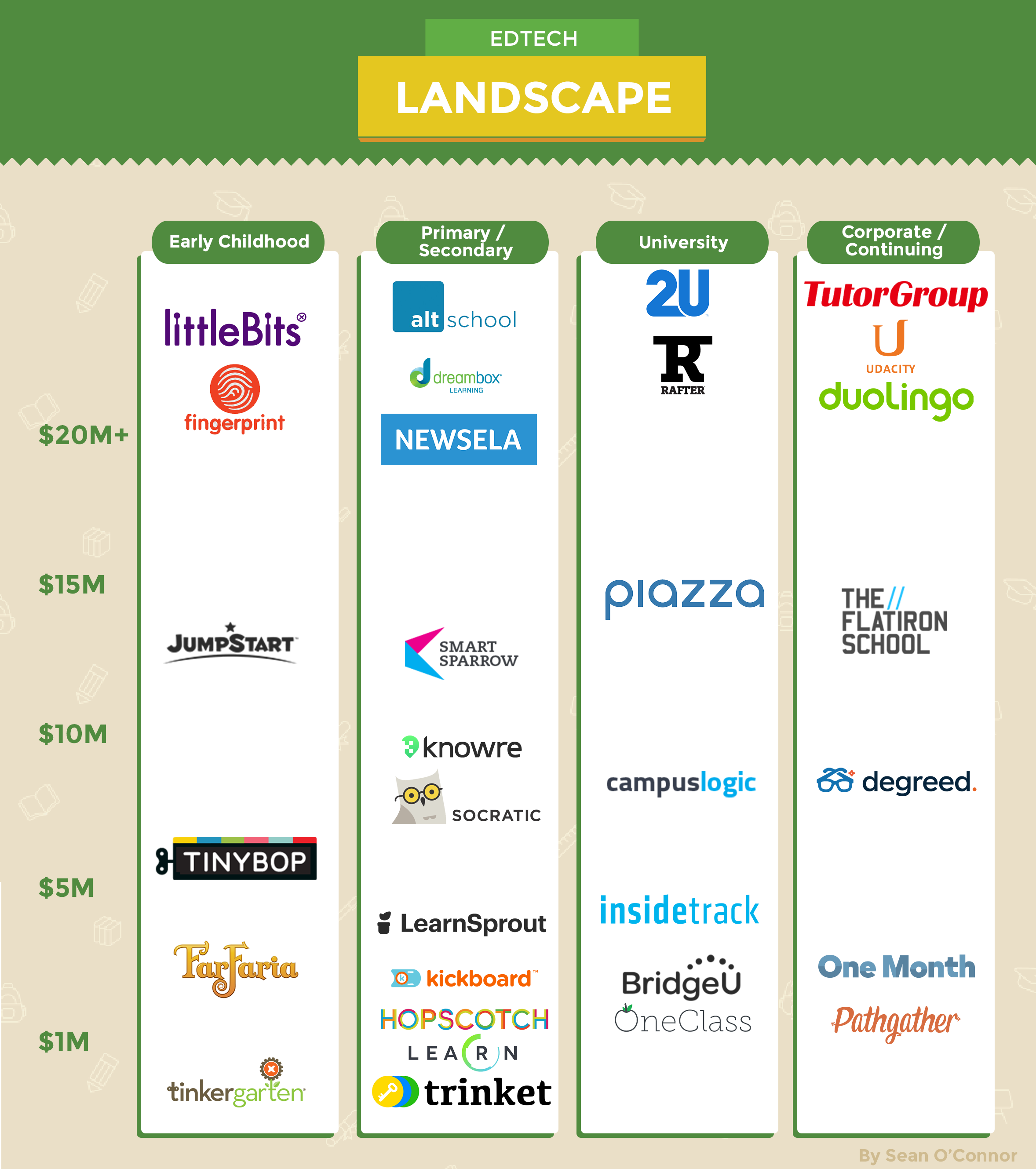
Early childhood
- FarFaria: FarFaria is a literacy tool that offers families a vast library of books that are perfect for story time. Parents can go through the books with their son or daughter, or children can have the books read to them by the app.
- Tinybop: Tinybop creates iOS apps that engage children and promote curiosity in kids. Their apps break down complex subjects (like geology and anatomy) into engaging apps that are filled with stunning illustrations.
- Vroom: Vroom is a new app that pushes helpful tips to parents on how to turn everyday moments in life into brain-building opportunities. Vroom sends parents actionable tips and strategies that are age-appropriate for their child.
- Tinkergarten: Tinkergarten helps kids develop and grow through outdoor-play-based learning and activities. They have a technology-enabled, distributed workforce that allows them to expand their classes across the United States.
Primary/secondary school
+++++++++++++++++++++
My Note:
“although 95 percent of schools have Internet, only 20 percent have high-speed access. For technology to disrupt our schools, we need to get them connected.”
yet, MN government is right now quarreling about fast-connection networking rural parts of Minnesota, whereas the Republicans insist on $30 Mil only, Democrats on $80Mil and the governor on $100K+.
In 2002, the U.S. created the conditions for monopoly in the Internet services providers market, which accumulates to disastrous results. The fight around net neutrality proves one more time that trend (of monopolizing connectivity and profiteering for big companies, rather then developing the US):
http://www.npr.org/sections/alltechconsidered/2014/02/06/272480919/when-it-comes-to-high-speed-internet-u-s-falling-way-behind
++++++++++++++++++++++
Trend: One of the major developments in primary and secondary education is the focus on personalization. Students get pushed material that meets them where they are, when they need it. Classes can now adapt to a learner’s needs and provide them with the skills, the instruction and the resources they need to master concepts.
- AltSchool: AltSchool was started in 2013 and is rethinking the way school works. Their technology platform enables teachers to create weekly “learning playlists” for each student. They’ve done away with formal classes and focus on group projects and individualized instruction.
- CK-12: The CK-12 Foundation serves tens of thousands of schools and millions of students by providing free customizable learning tools and content. Students can use their interactive simulations and adaptive problem sets and teachers can customize their flexbooks.
- DreamBox: DreamBox powers more than 5 million math lessons every week through their adaptive K-8 math platform. The platform continually assesses a student’s strengths and weaknesses to close gaps and meet students with the right material at the right time.
- Trinket: Trinket lets teachers and students write, run and share code from any device. Trinkets can be easily adapted to the classroom and shared with students to run real-time coding challenges.
University
College is expensive in America; the average cost is more than $20,000 a year for a four-year degree. At least 65 percent of the 55 million new jobs forecasted for the next decade will require a formal post-secondary credential.
In 2015, only 50 percent of college graduates were working in the field they studied, and more than one-third indicated they would have chosen a different major. Nearly 40 percent of college graduates believed their school did not prepare them well for employment.
Students are going to university because it is “the right thing to do,” often without a thought to the ROI on their education or the work opportunities after school. Only 19 percent of full-time college students graduate in four years, which dramatically increases the cost of their degree.
Trend: Online platforms are being leveraged at universities to help drive down the cost of a degree and increase access to programs. Big data platforms are being used to identify students in danger of failing and provide targeted assistance to help them graduate on time.
- Rafter: Rafter is redesigning textbooks at universities by repackaging course materials. They’ve helped almost 3 million students save more than $700 million on textbooks.
- 2U: 2U offers schools as a service by providing universities with a platform to create online degree programs. They have more than 500 faculty, 1,000 course sections and 1,600 hours of live instruction per week.
Corporate/continuing education
Trends: The two largest sectors for investment are skill training (primarily coding and digital literacy) and English language learning.
- Degreed: Degreed provides a personal knowledge portfolio that stays with learners. They’ve cataloged 250,000+ online learning courses and 3 million-plus informal learning activities. They also help large companies understand the talent and skills within their organization.
- Duolingo: Duolingo is a gamified language learning app that has more than 100 million users. They offer free instruction and are helping non-native English speakers certify their skills with affordable online testing.
- Pathgather: Pathgather is an enterprise LMS that motivates employees to learn and connect around professional development.
- iTutorGroup: iTutorGroup is a Chinese-based English language platform that began by offering English language training to corporate executives and has expanded to offer online courses for children and younger learners. They recently raised a Series C valuing them at more than $1 billion.
- One Month: One Month offers technical-skills crash courses designed to give learners functional skills in 15 minutes a day for one month. Since starting, they’ve helped more than 25,000 students develop foundational technical skills.
- altMBA: altMBA is an intensive, four-week online workshop designed by Seth Godin for high-performing individuals who want to level up and lead. They are rethinking the structure of learning online and have seen a 98 percent completion rate for their program.
2015 Student and Faculty Technology Research Studies
https://library.educause.edu/resources/2015/8/2015-student-and-faculty-technology-research-studies
Report: https://library.educause.edu/~/media/files/library/2015/8/ers1510ss.pdf?la=en
Infographic: ECAR_2015
++++++++++++++++++
Study of Students and Information Technology, 2014
https://library.educause.edu/resources/2014/10/2014-student-and-faculty-technology-research-studies
report: https://library.educause.edu/~/media/files/library/2014/10/ers1406.pdf
Infographic: ECAR_2014
++++++++++++++++
Higher Ed: EDUCAUSE Releases ECAR Study of Undergraduate Students and Information Technology 2013
Gary Price
Direct to Full Text Report (49 pages; PDF)

++++++++++++++++++++++++++
ECAR 2011

|
|
| Student’s relationship with technology is complex. They recognize its value but still need guidance when it comes to better using it for academics. |
Educause’s ECAR Study, 2013 |
InforMedia Services
|
IMS faculty would be happy to meet with you or your group at your convenience.
Please request using this Google Form: http://scsu.mn/1OjBMf9 or
by email: pmiltenoff@stcloudstate.edu | informedia@stcloudstate.edu
Here is the evaluation form: http://bit.ly/imseval |
How you can reach us:
Services we provide:
- Instruct and collaborate with faculty, staff and students on specific computer, Cloud and mobile applications
- Assist faculty in course design and instruction to incorporate SCSU’s resources
- Join faculty in the classroom instructional design to assist students with learning technology application for the class
- Consult with faculty on instructional design issues, particularly those that use the World Wide Web, multimedia techniques and interactivity
- Collaborate with faculty, staff and students on technology-related projects
- Work with campus units in technology planning and acquisition
- Respond to faculty, staff and students requests and technology developments
|

     |
Desire2Learn (D2L), Digital literacy, digital photography, e-learning, educational technology, gamification, gaming, image editing, interactive apps, learning, lecture capture, Millennials, mobile apps, mobile apps, mobile devices, mobile learning, MOOC, online learning, Photoshop, podcasting, programming languages, smartboard, social media, teaching, technology, technology literacy, video editing, virtualization, web conferencing platform, web development, web editingAdobe Connect, Coding, customer satisfaction, e-learning, education, feedback, IMS, online learning, satisfaction survey, technology, technology instruction, workshops
Save
Save
Save
Save
LITA listerv has an useful discussion on stock photos:
eturner@gcls.org:
free stock images under Creative Commons licenses we like to use:
https://www.pexels.com/
https://stocksnap.io/
https://unsplash.com/
++++++++++
Junior Tidal <jtidal@CityTech.Cuny.Edu>
NYPL also has a public domain collection – http://www.nypl.org/research/collections/digital-collections/public-domain
++++++++++++
John Blyberg <john@blyberg.net>
https://github.com/heyalexej/awesome-images
+++++++++++++++
Lisa Bunker <Lisa.Bunker@pima.gov>
sample searches to see if they have good images for you. http://www.thinkstockphotos.com/
+++++++++++++++
Mark Beatty <mbeatty@ala.org>
https://search.creativecommons.org/
++++++++++++
Corey Seeman <cseeman@umich.edu>
Flickr users have a large number of items that are available under Creative Commons:
https://www.flickr.com/creativecommons/
++++++++++
For Social Media and Presentations: Free Image Sources
+++++++++++
yvonner@ranchomiragelibrary.org:
Dollar Photo for stock images. They are closing down as of April 15th. Does anyone use another vendor that comparable? We loved that fact that we could prepay for credits ($1 per image) rather than pay for a monthly subscription.
More on free images in this IMS blog:
https://blog.stcloudstate.edu/ims/?s=free+image&submit=Search
purpose: draft a document for the provost to plan for charting the future goal 3.12 “develop a comprehensive strategy to increase awareness and development of e-textbooks and open educational resources (OERs)”
\\STCLOUDSTATE\HuskyNet\DeptFiles\LRS\ETextbooks
SCSU goal: to reduce the cost of textbooks as an affordable learning initiative. Amount of reduction is undetermined
my notes based on the material below:
- best, most applicable source for the purpose of this research: U of Alberta Committee’s notes on the learning environment:
http://www.governance.ualberta.ca/en/GeneralFacultiesCouncil/CommitteeontheLearningEnvironm/~/media/Governance/Documents/GO05/LEA/15-16/WEB/Item-4-eTextbook-Subcommittee-Report-CLE-TLAT.pdf
the Canadians are using (citing) Acker (Ohio) in their research.
- best, most applicable source in terms of the logistics on e-texbooks creation and its pedagogical argumentation is this document from New Zealand: https://akoaotearoa.ac.nz/download/ng/file/group-7/guidelines-for-developing-interactive-etextbooks-on-net-tablets.pdf
- According to Bossaler et al (2014), it might be worth considering that SCSU (MnSCU?) must go first through implementing of e-text[books] in courses first by using publisher materials and then by using “in-house” produce. At this point, SCSU does NOT have an aligned policy of integrating e-texts in courses across campus. Lack of such experience might make a strategy for adoption of e-textbooks much more complex and difficult to implement
- stats are colored in green for convenience. Stats regarding the increase in textbook costs are re-printed from author to author: e.g. Acker (2011, p. 42). Murey and Perez (2011, p. 49 (bottom) – 50 (up)) reports stats from 2009 and projections for 2013 regarding etexbook adotion. Same authors, p. 50 second paragraph reports good stats regarding texbooks’ price increase : US$1122 per year for textbooks in 2010.
- Wimmer at al (2014) presents a lucid graphic of the structure of the publishing process (see bottom of this blog entry for citation and perm link).
- Wimmer at al (2014) discusses copyright and permissions, which is of interest for this research (p. 85)
- regarding in-house creation of e-textbooks, see (Distance education, e-learning, education and training, 2015). It very much follow the example of SUNY, which Keith was laying out: a team of faculty charged with creation the e-textbook for mass consumption.
Besides the SUNY model Keith is envisioning for MnSCU (comparable), there is the option of clustering OER sources: e.g. NASTA as per Horejsi (2013), CourseSmart. FlatWorld Knowledge (Murrey and Perez, 2011) etc.
- Hamedi & Ezaleila (2015) present an entire etextbook program. Article has been ordered through ILL. Same with Joseph (2015).
- Open Educational Resources in Acker (2015, p. 44-47). Also in Murey and Perez (2011, p. 51).
Also in ICWL (Conference) (13th : 2014 : Tallinn, E., & Cao, Y. (2014): OpenDSA
- Different models of pricing also in Acker (2015, p. 48). Keith touched on that
- students learn equally well from etextbooks as from paper ones: Taylor (2011)
- pedagogy
responses from colleagues:
Scott Robison, sarobison@mail.plymouth.edu: sparc-liboer@arl.org listserv
Jeff Gallant, Jeff.Gallant@usg.edu: David Ernst with the U and Ashley Miller from Ohio State U: dernst@umn.edu. Ashley’s is miller.6275@osu.edu.
definition e-textbook and
an electronic version of a printed book that can be read on a computer or handheld device designed specifically for this purpose.
-
a dedicated device for reading electronic versions of printed books.
Definition of: e-book
my note: there is no good definition about e-textbook in terms of the complexity, which e-textbook on campus might involve.
Considering Wimmer et al (2014) account on their campus experience in publishing e-textbook, a textbook may involve an LMS (Canvas) and blog (WordPress). Per my proposal during the F2F meeting, and following Rachel’s suggestion about discrimination of the different types of e-textbooks, here is an outline of e-textbook definition:
*******************
working definition for e-textbook for the purposes of SCSU:
e-textbook is a compilation of textual, multimedia and interactive material, which can be viewed on various electronic devices. E-textbook can: 1. be purchased from a publisher; 2. compiled in HTML format on faculty or group web space; 3. compiled on the content module of LMS (BB, D2L, Canvas, Moodle, etc.) 4. compiled on LMS (BB, D2L, Canvas, Moodle, etc.) and including all interactive materials: e.g. hyperlinks to MediaSpace multimedia, quizzes, etc.; 5. compiled on special apps, such as iBook Author, eCub, Sigil.
*******************
e-book
(Electronic-BOOK) The electronic counterpart of a printed book, which can be viewed on a desktop computer, laptop, smartphone, tablet or e-book reader (e-reader). When traveling, a huge number of e-books can be stored in portable units, dramatically eliminating weight and volume compared to paper. Electronic bookmarks make referencing easier, and e-book readers may allow the user to annotate pages.
Although fiction and non-fiction books come in e-book formats, technical material is especially suited for e-book delivery because it can be searched. In addition, programming code examples can be copied, which is why CD-ROMs that contained examples or the entire text were often packaged inside technical paper books.
E-Book Formats
Wimmer, Morrow, & Weber: Collaboration in eTextbook Publishing
There are several e-book formats on the market, including EPUB, Mobipocket (PRC, MOBI), eReader (PDB), Kindle (AZW, KF8) and Apple iBook (EPUB variation). Many e-readers also accept generic formats, including Adobe PDF and plain text (TXT).
——————
Electronic Textbooks or Paper Textbooks: What Are Students Reading?
According to a United States Government report, textbook prices have increased at over twice the rate of inflation in the last couple of decades. According to another report, the average student spends between $700 and $1,000 per year on textbooks while the cost of e-textbooks can be as much as 50% lower than paper textbooks.
Oxford dictionary, an electronic book or e-book is “an electronic version of a printed book that can be read on a computer or handheld device designed specifically for this purpose.” An e-textbook is defined as an e-book used for instructional or educational purposes and often includes features such as bookmarking, searching, highlighting, and note-taking as well as built-in dictionaries and pronunciation guides, embedded video-clips, embedded hyperlinks, and animated graphics.
E-textbooks have moved from occasional usage to a mainstream technology on college campuses. According to the Association of American Publishers, sales of e-books hit over $90 million; this is up over 200% when compared to the same month the previous year. When the cost of textbooks and the availability of formats are considered, the use of an e-textbook in the classroom may be the reasonable choice.
—————–
A
digital textbook is a digital book or
e-book intended to serve as the text for a class. Digital textbooks may also be known as
e-textbooks or
e-texts. Digital textbooks are a major component of technology-based education reform. They may serve as the texts for a traditional face-to-face class, an online course or degree.
The concepts of
open access and
open source support the idea of
open textbooks, digital textbooks that are free (gratis) and easy to distribute, modify and update
https://en.wikipedia.org/wiki/Digital_textbook—————-
Exploring Students’ E-Textbook Practices in Higher Education
- Authors: by Aimee Denoyelles, John Raible and Ryan Seilhamer Published: Monday, July 6, 2015. Instructional Designers, University of Central Florida
According to the United States Government Accountability Office, prices have increased 82 percent from 2002 to 2012.3 This cost sometimes drives students to
delay or avoid purchasing textbooks. Digital materials such as e-textbooks may offer a more cost-effective alternative.
4 Also, the expectation for digital materials is gaining strength in the K–12 sector.
5 For example, Florida school districts set a goal to spend at
least half of classroom material funding on digital materials by the 2015–2016 school year. Given that 81 percent of first-time-in-college (FTIC) undergraduate students hailed from a Florida public high school during the fall 2014 semester at the University of Central Florida (UCF), it is important to anticipate student expectations of digital materials. Finally, the availability of digital materials has risen exponentially with the incredible popularity of mobile devices.
Key Issues
Despite the advantages that e-textbooks pose, such as interactive features and accessibility on mobile devices, several barriers exist regarding implementation in higher education, namely non-standardization of the platform, limited use by students, and the unclear role of the instructor in adoption.
a survey questionnaire in 2012 that explored basic usage and attitudes regarding e-textbooks.
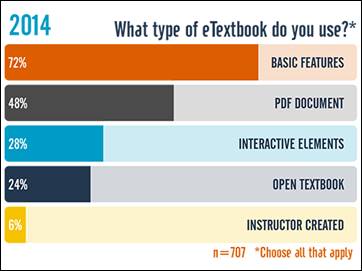




—————————–
Bossaller, J., & Kammer, J. (2014). Faculty Views on eTextbooks: A Narrative Study. College Teaching, 62(2), 68-75. doi:10.1080/87567555.2014.885877
http://login.libproxy.stcloudstate.edu/login?qurl=http%3a%2f%2fsearch.ebscohost.com%2flogin.aspx%3fdirect%3dtrue%26db%3dkeh%26AN%3d95094045%26site%3dehost-live%26scope%3dsite
Implementing eTexts into a Course:
- planning
- developing
- implementing
- delivering
This qualitative study gives insight into the experiences instructors have when working with publishers to integrate electronic content and technology into their courses.
Baek, E., & Monaghan, J. (2013). Journey to Textbook Affordability: An Investigation of Students’ Use of eTextbooks at Multiple Campuses. International Review Of Research In Open And Distance Learning, 14(3), 1-26.
http://eric.ed.gov/?id=EJ1017493
the Advisory Committee on Student Financial Assistance (2007) reported that textbook prices represent a significant barrier to students’ accessibility to textbooks. The report concluded that textbooks cost between $700-$1000 per year; textbook prices have risen much faster than other commodities; and that college aid fails to cover textbook expenses. Textbook costs are equivalent to 26% of tuition costs for an average four-year public university student and 72% of tuition costs for an average community college student. In fact, the California State Auditor (2008) reported that textbook costs grew more rapidly than student fees in academic year 2007–08.
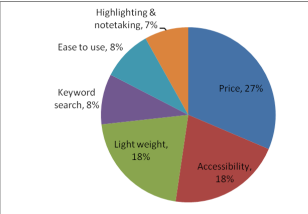
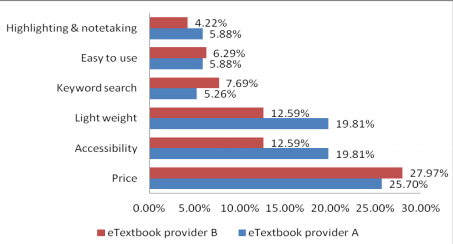
++++++++++++
Wimmer, E. e., Morrow, A. a., & Weber, A. a. (2014). Collaboration in eTextbook Publishing: A Case Study.Collaborative Librarianship, 6(2), 82-86.
http://login.libproxy.stcloudstate.edu/login?qurl=http%3a%2f%2fsearch.ebscohost.com%2flogin.aspx%3fdirect%3dtrue%26db%3dllf%26AN%3d108762075%26site%3dehost-live%26scope%3dsite
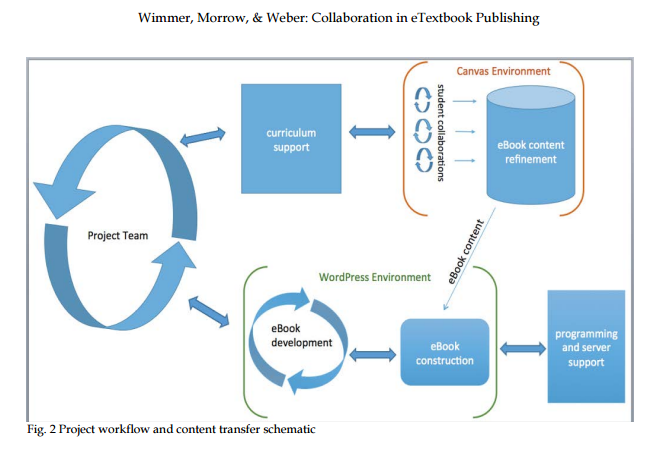
Distance education, e-learning, education and training. (2015). Clinical Chemistry & Laboratory Medicine, 53s557-s559. doi:10.1515/cclm-2015-5015
http://login.libproxy.stcloudstate.edu/login?qurl=http%3a%2f%2fsearch.ebscohost.com%2flogin.aspx%3fdirect%3dtrue%26db%3daph%26AN%3d102854748%26site%3dehost-live%26scope%3dsite
the creation of an interactive e-book called “Practical Clinical Chemistry: core concepts” was accomplished using the
Apple Macintosh platform and the iBooks Author software. Digital content, including videos, was developed for the
project and embedded within the final package. In order to limit the size of the final files, some content was uploaded
onto Youtube so that the user could access these via the internet.
The e-book, 200MB in size, was uploaded onto the Apple ITunes site and made available in 51 countries via the
iBooks store. This prototype is the first interactive digital textbook available in clinical chemistry and contains “4-
dimensional” content including digital images, videos, interactive presentations, real-time data generation as well as
review questions with instant feedback and assessment.
Hamedi, M., & Ezaleila, S. (2015). Digital Textbook Program in Malaysia: Lessons from South Korea. Publishing Research Quarterly, 31(4), 244-257. doi:10.1007/s12109-015-9425-4
Joseph, R. (2015). Higher Education Book Publishing-from Print to Digital: A Review of the Literature. Publishing Research Quarterly, 31(4), 264-274. doi:10.1007/s12109-015-9429-0
the author reflects the process on a state level (Ohio).
Marcoux, E. “. (2012). Best of the Best Planning. Teacher Librarian, 39(4), 69-70.
Taylor, A. K. (2011). Students Learn Equally Well From Digital as From Paperbound Texts. Teaching Of Psychology, 38(4), 278-281. doi:10.1177/0098628311421330
Much of the research related to digital texts has focused ontechnical aspects of readability (see Dillon, 1992, for a review) and limitations of digital media for note-taking, underlining, or highlighting text (Brown, 2001). However, the important—and unanswered—question from a teaching perspective is, ‘‘Can students learn as well from digital texts as from paperbound textbooks?’’ Few published studies have addressed this ques-tion directly, and even fewer studies have examined this ques-tion among college students.
Murray, M. C., & Pérez, J. (2011). E-Textbooks Are Coming: Are We Ready?. Issues In Informing Science & Information Technology, 849-60.
read the entire article, good data.
CourseSmart. FlatWorld Knowledge,
Horejsi, M. (2014). Textbooks 2.0. Science Teacher, 81(3), 8. http://login.libproxy.stcloudstate.edu/login?qurl=http%3a%2f%2fsearch.ebscohost.com%2flogin.aspx%3fdirect%3dtrue%26db%3daph%26AN%3d94603788%26site%3dehost-live%26scope%3dsite
++++++++++++++
pedagogy
two Eastern Europeans (Moldova, Serbia) raise serious concerns about electronic textbooks
Španović, S. (2010). PEDAGOGICAL ASPECTS OF E-TEXTBOOKS. Odgojne znanosti. 12(2). 459-470.
Railean, E. (2015). https://prezi.com/sbidiadctrzo/beyond-textbook-digital-textbook-use-and-development/
http://www.governance.ualberta.ca/en/GeneralFacultiesCouncil/CommitteeontheLearningEnvironm/~/media/Governance/Documents/GO05/LEA/15-16/WEB/Item-4-eTextbook-Subcommittee-Report-CLE-TLAT.pdf :
- (Un)desirable features in etextbooks
- How etextbooks might affect course delivery
- Pilot projects that can help build institutional expertise
- Address how and where insights gained from pilot projects will be collected and
- made available
- People resources (e.g., instructional designers) that will be needed to assist
- instructors to use this technology
ICWL (Conference) (13th : 2014 : Tallinn, E., & Cao, Y. (2014). New horizons in web based learning: ICWL 2014 international workshops, SPeL, PRASAE, IWMPL, OBIE, and KMEL, FET, Tallinn, Estonia, August 14-17, 2014, revised selected papers. Cham: Springer.
++++++++++++++++++++
MnSCU will by as Content Authoring Tool – SoftChalk. Here is a promo from Softchalk (my bold):
NEW SoftChalk Create 10 and SoftChalk Cloud eBook publishing features will arrive on April 25th! Come check out the latest enhancements at our upcoming webinars!
Sleek Designer Headers and Callout Boxes – Add some new pizazz to your SoftChalk lessons!
Three New Quiz Types – Test your students’ understanding with Sentence Completion, Multiple Blanks and Feedback Questions.
Polished New QuizPopper and Activity displays – With an enhanced interface for instructors and students.
Accessibility enhancements – Make your lessons available to everyone with even more accessibility enhancements.
NEW SoftChalk Cloud eBook creation and publishing – Includes a totally re-vamped, easier eBook creation and management. New SoftChalk eReader apps available for free download in the iOS, Android, Chromebook and Windows app stores. (Cloud Only)
+++++++++++++++++++++++++++
The future of textbooks looks like this
February 22nd, 2016
are any faculty really going digital? Which content distributors will thrive? What are the implementation concerns? And when will going digital really happen?
two massive surveys and reports by the National Association of College Stores (NACS) and the Independent College Bookstore Association (ICBA) in partnership with the Campus Computing Survey (CCS),
ACRL e-Learning webcast series: Learning Analytics – Strategies for Optimizing Student Data on Your Campus
This three-part webinar series, co-sponsored by the ACRL Value of Academic Libraries Committee, the Student Learning and Information Committee, and the ACRL Instruction Section, will explore the advantages and opportunities of learning analytics as a tool which uses student data to demonstrate library impact and to identify learning weaknesses. How can librarians initiate learning analytics initiatives on their campuses and contribute to existing collaborations? The first webinar will provide an introduction to learning analytics and an overview of important issues. The second will focus on privacy issues and other ethical considerations as well as responsible practice, and the third will include a panel of librarians who are successfully using learning analytics on their campuses.
Webcast One: Learning Analytics and the Academic Library: The State of the Art and the Art of Connecting the Library with Campus Initiatives
March 29, 2016
Learning analytics are used nationwide to augment student success initiatives as well as bolster other institutional priorities. As a key aspect of educational reform and institutional improvement, learning analytics are essential to defining the value of higher education, and academic librarians can be both of great service to and well served by institutional learning analytics teams. In addition, librarians who seek to demonstrate, articulate, and grow the value of academic libraries should become more aware of how they can dovetail their efforts with institutional learning analytics projects. However, all too often, academic librarians are not asked to be part of initial learning analytics teams on their campuses, despite the benefits of library inclusion in these efforts. Librarians can counteract this trend by being conversant in learning analytics goals, advantages/disadvantages, and challenges as well as aware of existing examples of library successes in learning analytics projects.
Learn about the state of the art in learning analytics in higher education with an emphasis on 1) current models, 2) best practices, 3) ethics, privacy, and other difficult issues. The webcast will also focus on current academic library projects and successes in gaining access to and inclusion in learning analytics initiatives on their campus. Benefit from the inclusion of a “short list” of must-read resources as well as a clearly defined list of ways in which librarians can leverage their skills to be both contributing members of learning analytics teams, suitable for use in advocating on their campuses.
my notes:
open academic analytics initiative
https://confluence.sakaiproject.org/pages/viewpage.action?pageId=75671025
where data comes from:
- students information systems (SIS)
- LMS
- Publishers
- Clickers
- Video streaming and web conferencing
- Surveys
- Co-curricular and extra-curricular involvement
D2L degree compass
Predictive Analytics Reportitng PAR – was open, but just bought by Hobsons (https://www.hobsons.com/)
Learning Analytics
IMS Caliper Enabled Services. the way to connect the library in the campus analytics https://www.imsglobal.org/activity/caliperram
student’s opinion of this process
benefits: self-assessment, personal learning, empwerment
analytics and data privacy – students are OK with harvesting the data (only 6% not happy)
8 in 10 are interested in personal dashboard, which will help them perform
Big Mother vs Big Brother: creepy vs helpful. tracking classes, helpful, out of class (where on campus, social media etc) is creepy. 87% see that having access to their data is positive
librarians:
recognize metrics, assessment, analytics, data. visualization, data literacy, data science, interpretation
INSTRUCTION DEPARTMENT – N.B.
determine who is the key leader: director of institutional research, president, CIO
who does analyics services: institutional research, information technology, dedicated center
analytic maturity: data drivin, decision making culture; senior leadership commitment,; policy supporting (data ollection, accsess, use): data efficacy; investment and resourcefs; staffing; technical infrastrcture; information technology interaction
student success maturity: senior leader commited; fudning of student success efforts; mechanism for making student success decisions; interdepart collaboration; undrestanding of students success goals; advising and student support ability; policies; information systems
developing learning analytics strategy
understand institutional challenges; identify stakeholders; identify inhibitors/challenges; consider tools; scan the environment and see what other done; develop a plan; communicate the plan to stakeholders; start small and build
ways librarians can help
idenfify institu partners; be the partners; hone relevant learning analytics; participate in institutional analytics; identify questions and problems; access and work to improve institu culture; volunteer to be early adopters;
questions to ask: environmental scanning
do we have a learning analytics system? does our culture support? leaders present? stakeholders need to know?
questions to ask: Data
questions to ask: Library role
learning analytics & the academic library: the state of the art of connecting the library with campus initiatives
questions:

literature
causation versus correlation studies. speakers claims that it is difficult to establish causation argument. institutions try to predict as accurately as possible via correlation, versus “if you do that it will happen what.”
++++++++++++
More on analytics in this blog:
https://blog.stcloudstate.edu/ims/?s=analytics&submit=Search
THE OCULUS RIFT REVIEW: The future is finally here, and it’s beautiful
http://www.businessinsider.com/oculus-rift-virtual-reality-headset-and-games-review-2016-3
lengthy and detailed articles how to entertain with the new Oculus
+++++++++++++
Virtual Reality Whiz Palmer Luckey: Future Will Be ‘More Boring Than We Think’
http://www.npr.org/sections/alltechconsidered/2016/03/28/472168507/virtual-reality-whiz-palmer-luckey-future-will-be-more-boring-than-we-think
+++++++++++++
Rabey, Lisa. [Lita-L] Internet Of Things. 2016. E-mail.
A month or so ago, I asked on ALA Think Tank if anyone was using IoT in their libraries, and if so: what, how, when, where; details man, details! Other than someone asking me what the IoT is (https://en.wikipedia.org/wiki/Internet_of_Things), I got crickets.
Yesterday Jason Griffey wrote, “How libraries can save the internet of things from the web’s centralized fate” (https://boingboing.net/2016/03/28/how-libraries-can-save-the-int.html) and this got me wondering again: Is anyone doing something in library land with IoT?
++++++++++++++
More on wearables in this IMS blog:
https://blog.stcloudstate.edu/ims/?s=oculus&submit=Search
More on virtual reality in this IMS blog:
https://blog.stcloudstate.edu/ims/?s=virtual+reality&submit=Search
Universal Design for Libraries and Librarians
Instructors: Jessica Olin, Director of the Library, Robert H. Parker Library, Wesley College; and Holly Mabry, Digital Services Librarian, Gardner-Webb University
Offered: April 11 – May 27, 2016
A Moodle based web course with asynchronous weekly content lessons, tutorials, assignments, and groups discussion.
Register Online, page arranged by session date (login required)
Universal Design is the idea of designing products, places, and experiences to make them accessible to as broad a spectrum of people as possible, without requiring special modifications or adaptations. This course will present an overview of universal design as a historical movement, as a philosophy, and as an applicable set of tools. Students will learn about the diversity of experiences and capabilities that people have, including disabilities (e.g. physical, learning, cognitive, resulting from age and/or accident), cultural backgrounds, and other abilities. The class will also give students the opportunity to redesign specific products or environments to make them more universally accessible and usable.
Takeaways
By the end of this class, students will be able to…
- Articulate the ethical, philosophical, and practical aspects of Universal Design as a method and movement – both in general and as it relates to their specific work and life circumstances
- Demonstrate the specific pedagogical, ethical, and customer service benefits of using Universal Design principles to develop and recreate library spaces and services in order to make them more broadly accessible
- Integrate the ideals and practicalities of Universal Design into library spaces and services via a continuous critique and evaluation cycle
Here’s the Course Page
Jessica Olin is the Director of the Library, Robert H. Parker Library, Wesley College. Ms. Olin received her MLIS from Simmons College in 2003 and an MAEd, with a concentration in Adult Education, from Touro University International. Her first position in higher education was at Landmark College, a college that is specifically geared to meeting the unique needs of people with learning differences. While at Landmark, Ms. Olin learned about the ethical, theoretical, and practical aspects of universal design. She has since taught an undergraduate course for both the education and the entrepreneurship departments at Hiram College on the subject.
Holly Mabry received her MLIS from UNC-Greensboro in 2009. She is currently the Digital Services Librarian at Gardner-Webb University where she manages the university’s institutional repository, and teaches the library’s for-credit online research skills course. She also works for an international virtual reference service called Chatstaff. Since finishing her MLIS, she has done several presentations at local and national library conferences on implementing universal design in libraries with a focus on accessibility for patrons with disabilities.
Dates:
February 29 – March 31, 2016
Costs:
- LITA Member: $135
- ALA Member: $195
- Non-member: $260
Technical Requirements:
Moodle login info will be sent to registrants the week prior to the start date. The Moodle-developed course site will include weekly new content lessons and is composed of self-paced modules with facilitated interaction led by the instructor. Students regularly use the forum and chat room functions to facilitate their class participation. The course web site will be open for 1 week prior to the start date for students to have access to Moodle instructions and set their browser correctly. The course site will remain open for 90 days after the end date for students to refer back to course material.
Registration Information:
Register Online, page arranged by session date (login required)
OR
Mail or fax form to ALA Registration
OR
call 1-800-545-2433 and press 5
OR
email registration@ala.org










